In researching more about face primers for this post, I came across many unflattering comparisons between face primers and paint primers. I’m not fond of the analogy of makeup on one’s face to paint on a wall or canvas. But let’s face it: your face IS a canvas for makeup, and primer helps prep that canvas so that your makeup applies more smoothly and lasts longer.
What Do Primers Do?
There are a lot of different primers out there today, but they are all meant to smooth out the surface of your skin and fill in pores, fine lines, and wrinkles, which creates a smoother surface for smoother and easier foundation application. They also create a barrier that keeps your sebum (oils naturally produced by your skin throughout the day) from breaking down your foundation. Don’t worry, though; it’s a permeable barrier. Your skin can still breathe. Think of primer as being like a tea bag. Air can still get through; your skin will not suffocate when you use a primer. However, it still keeps your skin (along with your moisturizer/skincare/etc.) separate from your foundation/BB cream/etc. Additionally, because it creates this barrier, it can keep your foundation from oxidizing (when your foundation turns a few shades darker once applied to your face, as it mixes with your sebum). As long as you remove your makeup every night, primer will not clog your pores or cause breakouts (as with all cosmetics, they can cause you to break out if you are sensitive to a certain ingredient; therefore, I recommend that you check ingredients lists if you have known allergies/react poorly to particular ingredients, or patch test products before applying to your entire face, especially if you have sensitive skin).
Here are some other things primers can do (NOTE: Not all primers do all of these things!):
- Brighten or add dewiness to your face
- Color-correct (green for redness, purple for sallowness)
- Absorb oil/mattify/control oil throughout the day (Avoid these if you have dry skin. They will make your skin drier.)
- Tinted primers may provide some coverage (foundation on top will boost the coverage, or for those of you with even skin, the tint from the primer may be enough)
- Contain botanicals and other ingredients to soothe, refresh, and/or hydrate the skin
- Provide anti-aging benefits
You want to select a primer that does what you want it to do. This will be different for everybody. Read labels, reviews, etc. I highly recommend asking for samples, if possible. Samples allow you to try out a product and see how it feels, performs, and wears throughout the day. This way, you know if you like it before you buy it.
Water- vs. Silicone-Based Primers: What’s the Difference?
You don’t want to use a silicone-based primer if you use a water-based foundation. It can cause your foundation to pill and look powdery because the water in the foundation will not be able to absorb into your skin (which means your foundation won’t sit correctly on your skin). Water-based primers can work okay with silicone-based foundations because the water tends to absorb into the skin. Still, it’s something to be aware of it you’re experiencing pilling or powdery-ness. Click here to read my post on how to determine whether a product is water- or silicone-based.
Otherwise, whether you use a water- or a silicone-based primer is a matter of personal preference. If you don’t enjoy that silicone texture, you might consider trying a water-based primer.
While pore-filling primers, such as Benefit Porefessional, NYX Pore Filler, and Too Faced Primed and Poreless, are designed specifically to fill in your visible pores, you can also use any primer to do this as long as you tap them into your pores (this gets the product into your pores to fill them in). In my experience, though, pore-filling primers are best at filling in pores (duh), and silicone-primers are better at filling in pores than water-based primers.
Primer Application
Okay, you managed to choose a primer. Now, how do you apply? Technical jargon and complicated instructions incoming:
- Moisturize. I don’t care what skin type you have (even oily skin needs moisture). Use a moisturizer that is appropriate for your skin type. Apply sunscreen. Wait for your moisturizer and sunscreen to absorb completely (I can’t tell you how much time this will take, but your skin should no longer feel tacky from freshly-applied moisturizer and sunscreen). You can use this time to do your eyebrows and/or eye makeup (I like to do my eye makeup before foundation because fallout, if I get any, is easier to clean up before applying foundation), do your hair, do a bunch of jumping jacks, practice your “Blue Steel” face… It’s your time; do what you want!
- Squeeze out about a pea- or raisin-sized blob. A little goes a long way, so you really don’t need a lot. As stated above, primer creates a barrier. It does not work like glue. It doesn’t help “stick” your foundation to your skin. If you use too much primer (particularly a silicone-based primer; water-based primers tend to absorb into your skin better, while silicone-based primers create a silicone barrier on top of your skin), it can make your foundation slide off sooner and/or apply unevenly, which completely cancels out the entire purpose of a primer. Additionally, it’s easier to add more primer than to try and scrape primer off of your face. So just start with less and add a little bit more if you need it.
- Dab the primer onto your face. This just ensures that you distribute the primer evenly all over your face.
- Rub the primer in. (Oh dear; I hope I didn’t lose any of you.) Your entire face should be covered in a very thin layer. If you’re trying to fill in pores or fine lines and wrinkles, you want to tap your primer onto those areas. If your primer starts to pill off, then you have used way too much.
As you can see, the pores on the right side of my face (my right, your left) look much smaller than the pores on the left side of my face (my left, your right). This illustrates the difference between tapping and rubbing. So if you want to fill in those pores, make sure you tap, tap, tap!
- Wait about 15-20 seconds for your primer to dry. I recommend using this time to admire your smooth, smooth skin.
- Apply tinted moisturizer, foundation, concealer, BB cream, CC cream, ZZ cream (I am not aware of any ZZ creams, but I wouldn’t be surprised if some cosmetics company created one), and/or whatever else you like to wear.
Can You Use More Than One Primer At a Time?
Of course you can!
For example, I might use a mattifying/oil-control primer on my t-zone, where I tend to get oily, and another primer elsewhere, where my skin is normal. If I used a mattifying/oil control primer all over, I would dry up my normal areas. You don’t have to use just one primer all over your face, though, of course, you can if you want to.
Primer to Seal in Moisturizer
As previously mentioned, primer creates a (permeable) barrier on your skin. While doing research for this post, I found several mentions of using it at night to seal in your nighttime moisturizer /skincare (Mally mentions this use in her video when talking about her Perfect Prep Poreless Primer). So of course I had to test it out. I tried it for a few nights using Mally’s primer, since Mally specifically mentions this use of her primer. My skin is combination oily/normal. I found that this actually did help. Normally, when I wake up in the morning, my face is pretty greasy (I think because the moisturizer kind of evaporates or something while I’m sleeping, and my skin needs to produce more oil to keep itself moisturized). When I tried using the primer to seal in my moisturizer, I woke up with perfect skin. It felt very comfortable and was not at all greasy-looking or –feeling. However, I can’t say anything about the long-term effects because I’d have to do this for, well, a long time. Those of you with dry skin may especially want to give this a shot. Of course, you have to wash it off in the morning. I always wash my face in the morning to give myself a clean start.
Normally, when I wake up, my t-zone is SHINY SHINY SHINY SHINY SHINY SHIIIIIINYYYYYY!! But as you can see, my skin is pretty matte when I use primer to seal in my nighttime moisturizer/skincare. (Hopefully, I haven’t scarred you by showing you my morning face. Scroll back up to my completed face to see Pretty Kahlex, if you wish.)
I hope this has been helpful! Thank you for reading, and feel free to leave comments, questions, and feedback below
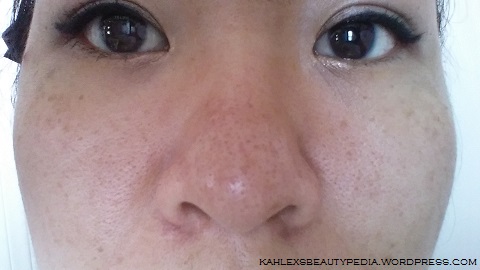
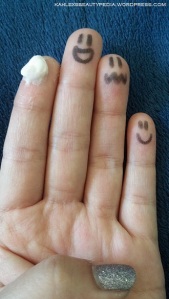
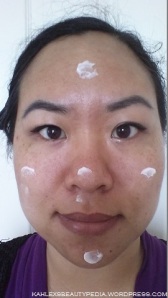
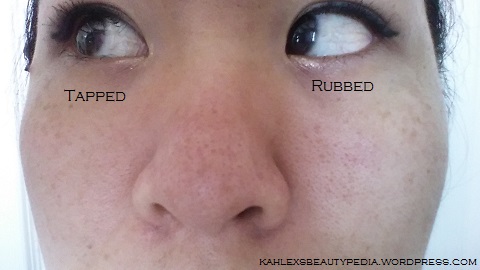
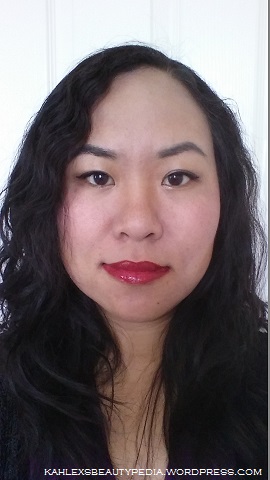
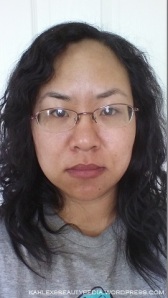
Pingback: Selecting the Right Foundation | kahlexsbeautypedia